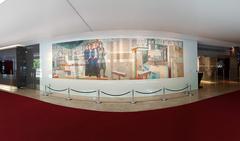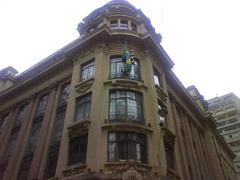Visiting Hours, Tickets, and Historical Insights of Capela Curial de São Francisco de Assis in Belo Horizonte
Date: 18/07/2024
Introduction
Nestled by the serene Pampulha Lagoon in Belo Horizonte, Brazil, the Capela Curial de São Francisco de Assis, also known as the Church of Saint Francis of Assisi, stands as a testament to the innovative spirit of mid-20th-century Brazilian architecture. Designed by the renowned architect Oscar Niemeyer, the chapel is part of the Pampulha Modern Ensemble—a UNESCO World Heritage Site since 2016 (UNESCO). This architectural marvel, completed in 1945, showcases Niemeyer’s innovative use of reinforced concrete and his fascination with organic, curvilinear forms. The chapel’s artistic and cultural significance is further enriched by the contributions of Cândido Portinari, who adorned the interior and exterior with murals depicting scenes from the life of Saint Francis of Assisi. Despite facing initial resistance from the Roman Catholic Church due to its unconventional design, the chapel was eventually consecrated in 1959, solidifying its place as a cultural and religious landmark (ArchDaily). This guide provides a comprehensive overview of the chapel’s rich history, architectural significance, visitor information, and practical tips to make the most of your visit.
Table of Contents
- Introduction
- History of Capela Curial de São Francisco de Assis
- UNESCO World Heritage Status
- Restoration Efforts
- Visitor Information
- Travel Tips
- FAQ
- Conclusion
- References
History of Capela Curial de São Francisco de Assis
Origins and Construction
The Capela Curial de São Francisco de Assis is a significant landmark in Belo Horizonte, Brazil. Its construction began in 1943 and was completed in 1945. The chapel is part of the Pampulha Modern Ensemble, a collection of buildings designed by the renowned Brazilian architect Oscar Niemeyer, with landscape design by Roberto Burle Marx and artwork by Cândido Portinari. This ensemble was commissioned by Juscelino Kubitschek, then the mayor of Belo Horizonte, who later became the President of Brazil.
Architectural Significance
The chapel is a prime example of modernist architecture, characterized by its innovative use of reinforced concrete and its organic, curvilinear forms. The design of the chapel broke away from traditional ecclesiastical architecture, embracing a more fluid and dynamic aesthetic. The building’s parabolic arches and undulating roofline are particularly notable, reflecting Niemeyer’s fascination with the possibilities of concrete as a medium.
Artistic Contributions
Cândido Portinari, one of Brazil’s most celebrated artists, contributed significantly to the chapel’s interior and exterior. His murals depict scenes from the life of Saint Francis of Assisi, the chapel’s namesake. These artworks are integral to the chapel’s identity, blending religious themes with modernist artistic expression. Portinari’s work on the chapel is considered some of his finest, showcasing his ability to merge narrative and form.
Controversies and Challenges
Despite its architectural and artistic significance, the chapel faced several controversies and challenges during its early years. The Roman Catholic Church initially refused to consecrate the chapel, citing its unconventional design and the perceived irreverence of some of Portinari’s murals. It wasn’t until 1959, nearly 14 years after its completion, that the chapel was finally consecrated and allowed to hold religious services.
UNESCO World Heritage Status
In 2016, the Pampulha Modern Ensemble, including the Capela Curial de São Francisco de Assis, was designated a UNESCO World Heritage Site. This recognition underscores the global significance of the chapel and its surrounding structures as masterpieces of modernist architecture and design. The UNESCO designation has helped to preserve the chapel and promote its historical and cultural importance to a broader audience.
Restoration Efforts
Over the years, the chapel has undergone several restoration efforts to preserve its structural integrity and artistic elements. These efforts have been crucial in maintaining the chapel’s original design and ensuring that future generations can appreciate its historical and cultural significance. The most recent restoration, completed in 2016, focused on repairing the concrete structure, restoring Portinari’s murals, and updating the chapel’s facilities to accommodate modern visitors.
Visitor Information
Visiting Hours and Tickets
The Capela Curial de São Francisco de Assis is open to the public from Tuesday to Sunday, with visiting hours typically from 9:00 AM to 5:00 PM. Tickets can be purchased at the entrance or online through the official Belo Horizonte tourism website. It’s advisable to check the website for the most up-to-date information on visiting hours and ticket prices.
Guided Tours
Guided tours are available and highly recommended to gain deeper insights into the chapel’s history, architecture, and artwork. These tours provide a comprehensive understanding of the chapel’s significance and the stories behind its creation.
Travel Tips
- Accessibility: The chapel is accessible to visitors with mobility challenges, with ramps and facilities to accommodate wheelchairs.
- Nearby Attractions: The Pampulha Lagoon area is home to several other attractions, including the Pampulha Art Museum and the Casa do Baile, making it a great destination for a full day of exploration.
- Photography: The chapel and its surroundings offer picturesque spots perfect for photography. Visitors are encouraged to capture the beauty of the chapel’s architecture and the tranquility of the lagoon.
FAQ
Q: What are the Capela Curial de São Francisco de Assis visiting hours? A: The chapel is open from Tuesday to Sunday, 9:00 AM to 5:00 PM. Check the official website for any updates.
Q: How much are the tickets for Capela Curial de São Francisco de Assis? A: Ticket prices vary; please refer to the Belo Horizonte tourism website for current prices and purchasing options.
Q: Is the chapel accessible for people with disabilities? A: Yes, the chapel has facilities to accommodate visitors with mobility challenges.
Conclusion
The Capela Curial de São Francisco de Assis stands as a testament to the innovative spirit of mid-20th-century Brazilian architecture and culture. Whether you’re an architecture enthusiast, an art lover, or simply looking for a serene place to reflect, the chapel offers a unique and enriching experience. Plan your visit today and immerse yourself in the history and beauty of this iconic landmark.
For more information on visiting the Capela Curial de São Francisco de Assis, please refer to the official Belo Horizonte tourism website. Stay up to date by following us on social media and checking out related posts on our blog.
References
- Niemeyer, O. (1996). The Curves of Time: The Memoirs of Oscar Niemeyer. Phaidon Press. source
- UNESCO World Heritage Centre. (2016). Pampulha Modern Ensemble. Retrieved from UNESCO
- Portinari, C. (2004). Portinari: His Life and Art. University of Texas Press. source
- Belo Horizonte City Hall. (2024). Capela Curial de São Francisco de Assis. Retrieved from Belo Horizonte City Hall




